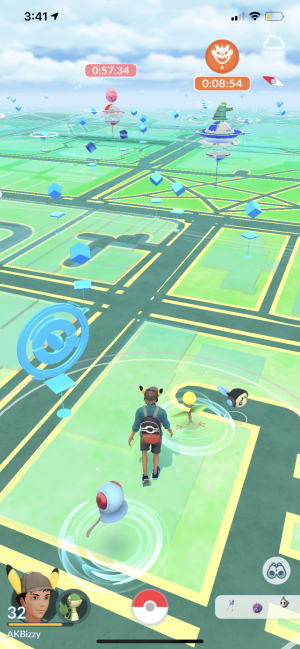Pokémon Go
Pokémon Go is an augmented reality (AR) game on mobile (Android, iOS) platforms developed by Niantic alongside The Pokémon Company. The game is part of the larger Pokémon franchise and uses GPS to find, capture and battle virtual Pokémon. The use of augmented reality in the game makes it appear as if the virtual monsters are appearing in the users’ real-world setting. The game follows a freemium business model, meaning it is free to play but supports in-app purchases that grant players access to additional in-game items. The game was originally released on July 6, 2016, with 150 Pokémon included for players to interact with but has now grown to include about 500 Pokémon as of 2020.[1]
Pokémon Go had a turbulent release. Both critics and consumers were very impressed by the innovative game-play and hooked by the nostalgia, however, both parties also had many complaints regarding the technical problems of the app which caused it to lose a lot of the steam it had built up prior to its release. Nevertheless, Pokémon Go is still credited with popularizing AR technology and location-based games. The game is also praised for promoting physical activity, and helping local businesses grow. Simultaneously, the game received a lot of bad press due to the multiple accidents, incidents, and public safety issues it allegedly enabled with its inherent game mechanics[2]. Since the game’s release, multiple governments have expressed concerns about security, leading to it being regulated in those countries. As of 2019, the game has had over one billion downloads with 147 million active users and has grossed $3 billion in revenue.[3]
Contents
Gameplay
Start Up
After creating an account in the game, players name and customize the appearance of their own avatar. The avatar is then placed on a map in the current location of the player’s real-world setting. The map contains ‘PokeStops’ and ‘Pokémon Gyms’ which are usually set as a real-world shop location, monument, or some other figure of local importance. PokeStops can be equipped with ‘Lure Modules’, which attract wilder and potentially rare Pokémon and Pokémon Gyms are meant to be team-based, capture-the-flag battles between three in-game teams the player can join, Yellow, Red, and Blue. Unfortunately, in the beginning, some of the gym locations were on private property or in dangerous locations, one particularly unsafe gym was located at the Korean Demilitarization Zone.[4][1] As the player moves around the real-world, their avatar will move in the same way around the map displayed within the game. The Pokémon that appear in the wild to be caught varies upon multiple factors including, location, rarity, and weather. Pokémon of different types will appear in different areas that would fit with their fictional habitats. For example, on bright sunny days, players will encounter more fire-type Pokémon, whereas, on cold gloomy days, ice-type Pokémon would appear more frequently. Some Pokémon were also kept exclusive to certain continents and regions..[1]
When players tap on a Pokémon appearing in the in-game map, they can choose to see the Pokémon in AR mode or with a virtual background. Both of the viewing settings include real-world aspects of depth and distance from the virtual creature thanks to the use of a smartphone’s inner gyroscope and camera. During the encounter, Players flick virtual “PokeBalls” to capture and Berries to aid in capturing the Pokémon. The different Berries increase the chances of a successful capture or increase the amount of “Candies” received. Candies, along with experience points, are received every time a Pokémon is caught. Every Pokémon evolutionary chain has its own candy which can be given to Pokémon of that evolutionary change in order to increase their Combat Power (CP) level or Evolve the Pokémon. The CP level of a Pokémon determines its effectiveness in battle and is a new edition to the Pokémon Series which previously used a Pokémon’s Health Power (HP) and Level to determine this.
Updates
As the game has been updated, more game-play features and new Pokémon are added to the experience. There was the addition of Pokémon Eggs, one of the many items players can receive from PokeStops and by completing in-game missions, which can be hatched by walking certain distances that the game tracks using the smartphone’s pedometer. Pokémon Raids was another feature added to facilitate the game’s group-play features. In Pokémon Raids, many players show up to a Gym where a powerful, often rare Pokémon will be waiting and a group of up to 20 players can work together to defeat it and have the opportunity to catch it. Like eggs and raids, most of the features added to the game are meant to bolster the inherent mechanics of the game like getting outside and working with other players..[5]
Controversy
As previously mentioned, Pokémon Go has had its fair share of controversy since its release. While issues such as inconvenient gym and PokeStop locations, buggy gameplay were resolved through early patches and updates, some of the more pressing issues surrounding the game are seemingly out of the developer’s control.
Accidents
One of the biggest issues since the game’s release has been the number of public accidents that have occurred due to people being distracted by the game. The first reports of traffic accidents came when the game launched in Japan. A driver who was playing the game accidentally struck and killed a woman crossing the road[6]. Many more incidents like this have happened all over the world. In response, Niantic implemented a couple of features that would cause warning signs to appear if the game suspected a player was playing while driving[7]. Also, every time the game is opened a message appears reminding players to be aware of their surroundings and avoid dangerous areas while playing. Governments can also reach out to the company and request the game to lower the traffic to certain areas if there are public concerns[8].
A Tool for Crime
Since the game relies heavily on the physical movements of the player in the real world, many harmful people took advantage of this mechanic and would set up Lure Modules or camp around gyms and areas where rare Pokémon could appear and would then assault, rob, or do some other terrible thing to the players who believe they are just playing the game. Since the game is marketed to younger demographics, there have been concerns about sex offenders taking advantage of the game to do terrible things. Niantic and The Pokémon Company, cannot program things in the game to curb this without making major changes to how the game works as a whole. As of 2019, all that has been done to combat this issue is to make sure in-game monuments are located in dangerous real-world locations and making all public events like raid battles and rare Pokémon appearances occur during the day rather than 24 hours. Many places, like New York state, have restricted access to the game from sex offenders and violent criminals whilst on parole[9].
Ethical Concerns
There are a few ethical concerns aimed towards the mobile game, specifically scrutinizing the use of AR. The AR mechanics of the game require a lot of data, data such as your location which is taken from your mobile device. Niantic’s AR-games, Pokémon Go included, can store a user’s location data up to 13 times a minute. Niantic CEO John Hanke is one of the leaders in the field of AR mapping technology who headed projects like Google Geo, which led to the creation of Google Maps and Google Earth.
Ethical Issues of AR
The ethics of AR are constantly being debated and many of the concerns surrounding the technology can be applied to the game itself since it’s fundamental mechanics rely on AR. Steve Mann, outlines many of the ethical issues surrounding AR technology in the paper “Veillance and Reciprocal Transparency: Surveillance versus Sousveillance, AR Glass, Lifeglogging, and Wearable Computing.” Mann describes the extent to which AR technology collects not only the user’s data but also the data of the surrounding area in order to perform the best calculations. Most devices that use some form of AR technology are acting as sousveillance agents, tracking unsuspecting people around the user. [10]
Before AR technology was in most people’s pockets it was being refined at companies like Google and in the military. The CIA invested in companies working on mapping technology for the purpose of military use. In-Q-Tel, an earlier developer of AR mapping, received an investment from the CIA to their AR mapping project Keyhole and within two weeks of the investment’s press release, the Pentagon used the technology for covert missions in Iraq. On the commercial side, Google received a lot of criticism during the initial launch of both Google Geo products. For Google Earth, many government bodies, both foreign and domestic, were concerned with the idea that anyone could determine the location of classified structures such as a military base. Google swiftly implemented measures to protect areas like this on their mapping technology, but the information had been public long enough to force some governments to move their private structures to different locations. For Google Maps, the biggest issue was in 2010 when Germany’s data protection commission discovered that the Google Street View vehicles were collecting unencrypted data from local Wifi networks like emails, medical information, financial records, audio and video files, and passwords. Hanke, who was still leading Google Geo at the time, claimed to be unaware of the code that allowed for this to happen being implemented. The company quickly apologized and fixed this error but in 2019 a book titled The Age of Surveillance Capitalism by Shoshana Zuboff explains that records show Google did know this collection was happening, citing emails from an employee who told his supervisors that Street View was collecting user data.[11]
Pokémon Go Issues
The concerns facing all of AR are reflected in the game itself. Similar to the issues with Google Street View, Pokemon Go was criticized for requesting many unnecessary permissions such as contacts, storage and, for iPhone users, full Google account access. Like with Google Geo, Hanke blamed this issue on a bug that he was unaware of. In 2019, media outlet Kotaku performed an investigation and found that the app was still tracking a user's location data while the app was not in use. When questioned about this, Niantic once again claimed this was a bug and simply removed the code that caused this. Kotaku’s 2019 investigation also revealed the extent to which the game tracks it's player and then how the data is used by the company and third parties. By following one user’s game data over a couple of months, Kotaku could determine the user’s wake-up time, morning route to work, favorite lunch spot, etc. Kotaku could essentially predict this user’s every movement in just a short period of time. The accuracy to which this data can reflect someone’s life is similar to what Luciano Floridi speaks about in The Fourth Revolution regarding the melding of our reality and the “infosphere”, the environment of information. By being able to understand and essentially see the real world from a collection of data points, the line between a digital data identity and reality is blurred.[12] [11]
Niantic claims that all of the data they track and use is anonymous and that they don't sell individual user data. The data collected by the game for Niantic is shared with third-parties as aggregate statistics, showing how many people traveled to a location, total foot traffic at different times, total interactions with in-game monuments in that area, etc. Third-parties primarily use this data to inform their marketing strategies, whether it be advertising within the game or just using the data to inform where to advertise in the real world. This raises the ethical issue of using a children’s game which preaches exploration and exercise to simultaneously sell products antithetical to those principles.
Many of the controversies the game faces are caused by the AR-mapping gameplay mechanics. As previously mentioned, often Pokemon or other in-game elements will appear on a location in the user's map which corresponds to a dangerous real-world location. Many people, often younger children, have been injured because they tried to travel to such a location in the real-world. This raises the ethical question of is Pokemon Go responsible for these injuries? As mentioned, the developers make constant updates and patches to the game to try and prevent this problem, but the algorithms they produce cannot be perfect. [11]
References
- ↑ 1.0 1.1 1.2 Bastow, Clem. "From Pokéstops to Pikachu: everything you need to know about Pokémon Go" 11 July 2016
- ↑ https://www.newscientist.com/article/2154881-did-pokemon-go-really-kill-250-people-in-traffic-accidents/
- ↑ Molina, Brett "Report: 'Pokémon Go' downloads top 15 million" 13 July 2016.
- ↑ https://www.dailydot.com/debug/pokemon-go-gym-north-korea-dmz/
- ↑ Niantic. "Updates"
- ↑ Ho, Victoria. "Japan suffers its first 'Pokémon Go' accident just hours after the game debuts", 22 July 2016.
- ↑ https://www.independent.co.uk/news/world/americas/pokemon-go-pokestops-washington-oregon-police-fire-sheriff-warning-jail-a7132751.html
- ↑ http://asia.nikkei.com/Politics-Economy/Policy-Politics/Thailand-to-insist-on-Pokemon-free-zones
- ↑ https://www.npr.org/sections/alltechconsidered/2016/08/02/488435018/new-york-bans-registered-sex-offenders-from-pok-mon-go
- ↑ Mann, Steve. "Veillance and Reciprocal Transparency:Surveillance versus Sousveillance, AR Glass, Lifeglogging, and Wearable Computing", Ontario. 27 June 2013.
- ↑ 11.0 11.1 11.2 Metha, Dhruv. "The Creators Of Pokémon Go Mapped The World. Now They're Mapping You", 16 October 2019.
- ↑ Floridi, Luciano. "Infosphere", 1 September 2014.


